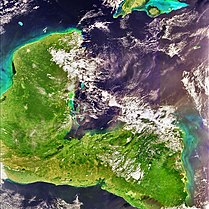
| Part of a series on |
| Central America |
|---|
 |
This is a list of the native wild mammal species recorded in Central America. Central America is usually defined as the southernmost extension of North America; however, from a biological standpoint it is useful to view it as a separate region of the Americas. Central America is distinct from the remainder of North America in being a tropical region, part of the Neotropical realm, whose flora and fauna display a strong South American influence. The rest of North America is mostly subtropical or temperate, belongs to the Nearctic realm, and has far fewer species of South American origin.
At present Central America bridges North and South America, facilitating migrations in both directions, but this phenomenon is relatively recent from a geological perspective. The formation of this land bridge through volcanic activity three million years ago precipitated the Great American Interchange, an important biogeographical event. In part because of this history, Central America is extremely biodiverse; it comprises most of the Mesoamerican biodiversity hotspot.[1] The mountains running down the spine of Central America have also contributed to biodiversity by creating montane habitats, including cloud forests and grasslands, and by separating species from the lowlands along the Pacific and Caribbean coasts. However, Central America's biodiversity suffered a blow in the Quaternary extinction event, which started around 12,500 cal BP, at roughly the time of arrival of Paleoindians; much of the megafauna died out at this time. The effects of modern human activities on climate and ecosystem integrity pose a further threat to Central America's fauna.
This list consists of those mammal species found from the Isthmus of Tehuantepec to the northwestern border of Colombia, a region including the Mexican states of Chiapas, Tabasco, Campeche, Yucatán and Quintana Roo, and the nations of Belize, Guatemala, El Salvador, Honduras, Nicaragua, Costa Rica and Panama. As of May 2012, the list contains 378 species, 177 genera, 47 families and 13 orders. Of the taxa from nonflying, nonmarine groups (203 species, 91 genera, 31 families and 10 orders), those of South American origin (opossums, xenarthrans, monkeys and caviomorph rodents) comprise 21% of species, 34% of genera, 52% of families and 50% of orders. Thus, South America's contribution to Central America's biodiversity is fairly modest at the species level, but substantial at higher taxonomic levels. In comparison to South America, a famously biodiverse continent, Central America has 27% as many species, 51% as many genera, 81% as many families and 86% as many orders (considering noncetacean taxa only), while having only 4.3% of the land area.
Of the species, two are extinct, eleven are critically endangered, thirteen are endangered, twenty are vulnerable, twenty are near threatened, thirty-five are data deficient and five are not yet evaluated.[n 1] Mammal species presumed extinct since AD 1500 (two cases) are included. Domestic species and introduced species are not listed.
Note: this list is almost inevitably going to be incomplete, since new species are continually being recognized via discovery or reclassification. Places to check for missing species include the Wikipedia missing mammal species list, including recently removed entries, and the species listings in the articles for mammalian genera, especially those of small mammals such as rodents or bats.
The following tags are used to highlight each species' conservation status as assessed by the International Union for Conservation of Nature; those on the left are used here, those in the second column in some other articles:
| EX | EX | Extinct | No reasonable doubt that the last individual has died. |
| EW | EW | Extinct in the wild | Known only to survive in captivity or as a naturalized population well outside its historic range. |
| CR | CR | Critically endangered | The species is in imminent danger of extinction in the wild. |
| EN | EN | Endangered | The species is facing a very high risk of extinction in the wild. |
| VU | VU | Vulnerable | The species is facing a high risk of extinction in the wild. |
| NT | NT | Near threatened | The species does not qualify as being at high risk of extinction but is likely to do so in the future. |
| LC | LC | Least concern | The species is not currently at risk of extinction in the wild. |
| DD | DD | Data deficient | There is inadequate information to assess the risk of extinction for this species. |
| NE | NE | Not evaluated | The conservation status of the species has not been studied. |
The IUCN status of the listed species was last updated between November 2008 and March 2009.
- ^ "Mesoamerica". Conservation International web site. Conservation International. Retrieved 2012-11-05.
Cite error: There are <ref group=n> tags on this page, but the references will not show without a {{reflist|group=n}} template (see the help page).
© MMXXIII Rich X Search. We shall prevail. All rights reserved. Rich X Search
